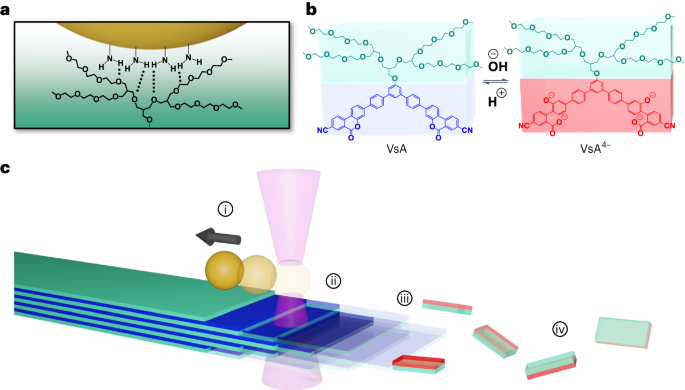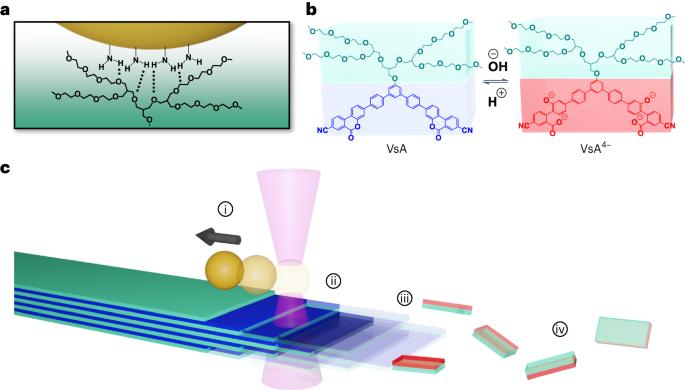通过定向分解微晶纤维在流体中施加拉力
IF 38.1
1区 材料科学
Q1 MATERIALS SCIENCE, MULTIDISCIPLINARY
引用次数: 0
摘要
生物分子聚合马达是一种利用超分子(去)聚合作用将化学势转化为有用机械功的生物化学系统。为了探索新的化学机械传导策略,我们在这里展示了一种合成分子系统,当它们自由悬浮在流体中时,可以通过控制晶格中自组织分子的分解来产生力。一种两亲性单体可自组装成刚性、高纵横比的微晶纤维。组装过程由一种基于香豆素的 pH 值切换图案调节。微纤维晶体形态决定了界面上的单体反应性,从而导致各向异性蚀刻。这种效应通过微弱的多价相互作用,对吸附在晶体表面的微珠产生定向拉力。我们使用基于光学镊子的力谱仪来提取这一过程的机理,量化了微纤维解体产生的棘轮机制所产生的 2.3 pN(±0.1 pN)的滞留力。本文章由计算机程序翻译,如有差异,请以英文原文为准。


Exerting pulling forces in fluids by directional disassembly of microcrystalline fibres
Biomolecular polymerization motors are biochemical systems that use supramolecular (de-)polymerization to convert chemical potential into useful mechanical work. With the intent to explore new chemomechanical transduction strategies, here we show a synthetic molecular system that can generate forces via the controlled disassembly of self-organized molecules in a crystal lattice, as they are freely suspended in a fluid. An amphiphilic monomer self-assembles into rigid, high-aspect-ratio microcrystalline fibres. The assembly process is regulated by a coumarin-based pH switching motif. The microfibre crystal morphology determines the monomer reactivity at the interface, resulting in anisotropic etching. This effect exerts a directional pulling force on microscopic beads adsorbed on the crystal surface through weak multivalent interactions. We use optical-tweezers-based force spectroscopy to extract mechanistic insights into this process, quantifying a stall force of 2.3 pN (±0.1 pN) exerted by the ratcheting mechanism produced by the disassembly of the microfibres. Disassembling molecular microcrystalline fibres produce mechanical work by dragging micro objects along their surface via biased diffusion.
求助全文
通过发布文献求助,成功后即可免费获取论文全文。
去求助
来源期刊

Nature nanotechnology
工程技术-材料科学:综合
CiteScore
59.70
自引率
0.80%
发文量
196
审稿时长
4-8 weeks
期刊介绍:
Nature Nanotechnology is a prestigious journal that publishes high-quality papers in various areas of nanoscience and nanotechnology. The journal focuses on the design, characterization, and production of structures, devices, and systems that manipulate and control materials at atomic, molecular, and macromolecular scales. It encompasses both bottom-up and top-down approaches, as well as their combinations.
Furthermore, Nature Nanotechnology fosters the exchange of ideas among researchers from diverse disciplines such as chemistry, physics, material science, biomedical research, engineering, and more. It promotes collaboration at the forefront of this multidisciplinary field. The journal covers a wide range of topics, from fundamental research in physics, chemistry, and biology, including computational work and simulations, to the development of innovative devices and technologies for various industrial sectors such as information technology, medicine, manufacturing, high-performance materials, energy, and environmental technologies. It includes coverage of organic, inorganic, and hybrid materials.
 求助内容:
求助内容: 应助结果提醒方式:
应助结果提醒方式:


